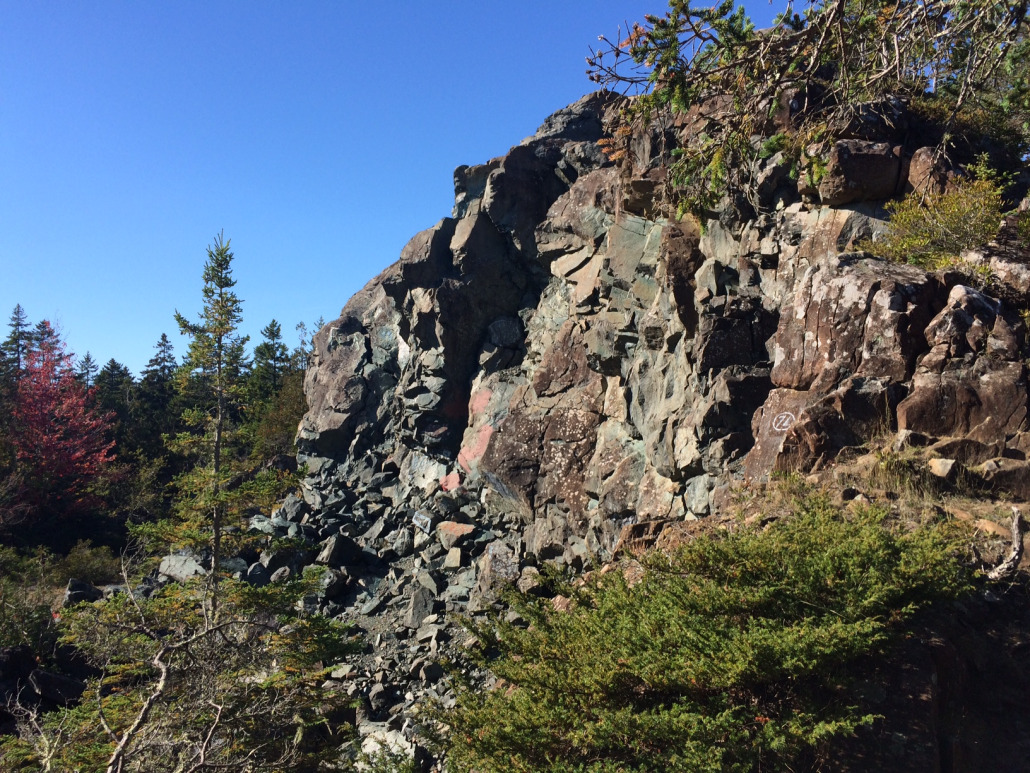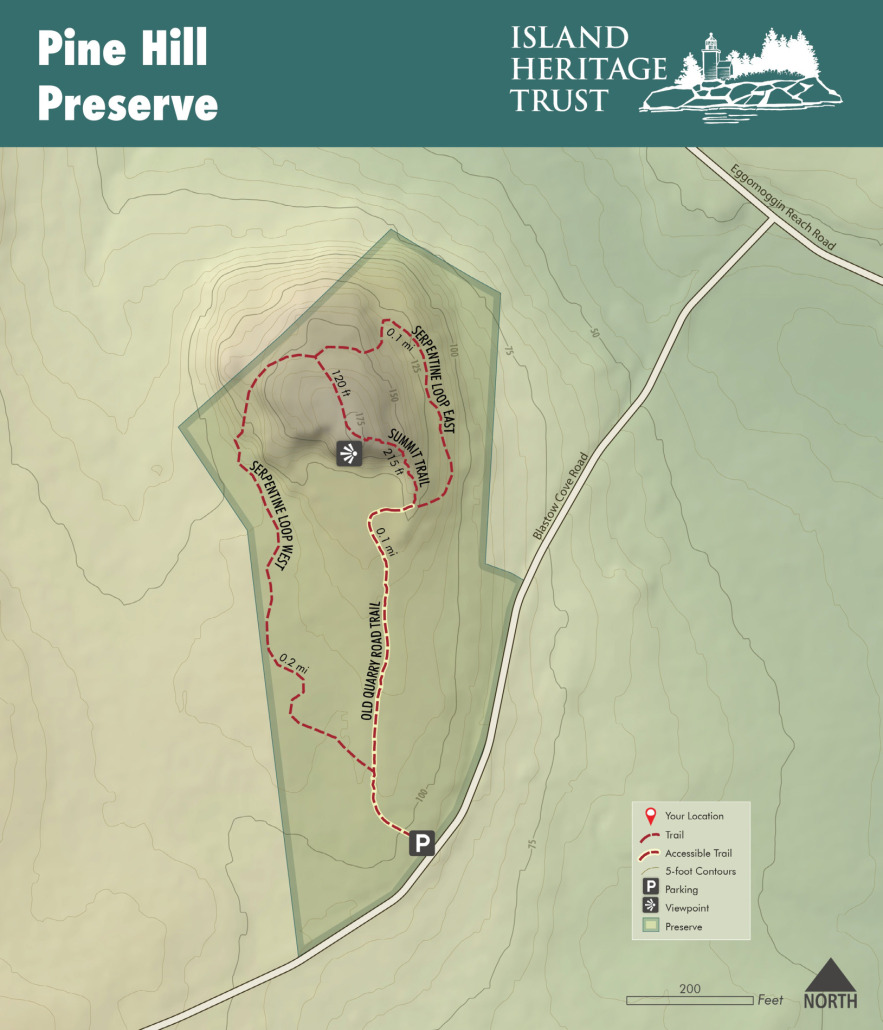PINE HILL PRESERVE, LITTLE DEER ISLE
Mixed woodland trail leads to an uncommon rock of national and international significance – serpentinized peridotite. At the top of the rock formation, enjoy scenic views of the Deer Isle bridge, Caterpillar Hill, and Penobscot Bay.
ACTIVITIES TO ENJOY AT PINE HILL:
- Hiking
- Geologic observation
- Scenic views
- Photography
.5 MILE TRAIL SYSTEM:
Traditional Rating: Easy – Hard
Accessibility Rating: Easy+ – Very Hard
The walk into the preserve takes you through a wooded area on a flat, wide trail that used to be the old quarry road. The trail to the top of Pine Hill provides a short, steep, and difficult climb. Be prepare to use hands and feet. Please stay on the trails to protect rare plants.
EXPLORE THE PRESERVE
Take a short, accessible trail to the base of the rock formation or explore a windy loop through a spruce-fir and white cedar forest to arrive at the scenic outlook. Enjoy varieties of mosses, lichens, and rare plants only found in this unique habitat.
PLEASE FOLLOW THESE GUIDELINES:
- Day Use Only – no camping or overnight parking
- Pets allowed under strict voice control – rare and fragile plants. The summit can be dangerous for off-leash pets.
- No fires allowed.
- Foot traffic only.
- Leave it better than you found it.
- Respect the privacy of our neighbors.
- Do not remove or damage plants – many are rare!
- Do not remove, collect rock samples or deface the rock
- Climbing at the quarry is not recommended. The rock is unstable and loose.
DIRECTIONS TO THE PRESERVE
From the Deer Isle bridge heading south, turn right before the Welcome Center on Little Deer Isle onto Eggemoggin Road. Drive northwest for .2 miles and turn left onto Blastow Cove Road. Pine Hill Preserve entrance and parking lot will be on your right.
GET TO KNOW THE FLORA & FAUNA
With Ecologist, Dr. Ken Crowell, & Naturalist, Marnie Reed Crowell:
“The unique chemistry of the rocks makes soil conditions here extremely harsh. Low levels of all major plant nutrients and high levels of magnesium, iron, chromium and nickel, toxic to many plants, make this a challenging place. The plants that do succeed here are often distinct from their closest relatives growing on more normal soils. They may be smaller or bloom earlier.
The tiny club mosses on the quarry floor (Selaginella) are relatively rare. Relative to the outcrop’s size, the tiny lichen plants of Pine Hill are particularly abundant even compared to other serpentine habitats. Sixty-three species have been identified including twenty-two that are uncommon in Maine and two not found anywhere else in New England. Even the common trees at Pine Hill (White Pine, White Spruce, and Eastern White Cedar) are stunted and grow very slowly.
Pine Hill provides a unique opportunity to study the role of natural selection in plant species diversification. To protect rare plants, please stay on the trail.
The climb up the rock structure takes you past several of the large white Pines which give the hill its name. White spruce and northern white cedar line the trail.”
Check Out the FULL Virtual Guided Walk through Pine Hill Preserve
GEOLOGY OF PINE HILL
Although locally known as the Serpentine Quarry, geologist Roger Hooke explains that the uncommon rock here is known as serpentinized peridotite. Peridotite is a coarse-grained igneous rock consisting mostly of mineral olivine, an iron-magnesium silicate. Hot fluids and sea water circulating through the rock altered the olivine to serpentine which when sheared smears out and gives the rock a green sheen almost like an enamel finish.
It is possible that the Pine Hill peridotite may be a chunk of seafloor caught up in the collision between the ancient core of North America and one of the slices of crust from Gondwana that swept against our shores 400-500 million years ago during the early Paleozoic. Geologist Douglas Reusch recently stated that the origin of this bedrock in the southern hemisphere is near certain.
Geoecologist, Nishanta Rajakaruna, further explains that peridotite belongs to the serpentine family of rocks that are very high in iron, magnesium silicate minerals. Soils weathered from peridotite are generally deficient in plant nutrients such as nitrogen, potassium, and phosphorus; have low calcium levels and elevated levels of heavy metals such as iron, nickel, chromium, and cobalt. Peridotite outcrops are generally rocky and exposed creating a demanding environment for plants.
While the age of Pine Hill bedrock is only loosely constrained to between 200 million and 500 million years old, the origin of Penobscot Bay bedrock in the southern hemisphere is near certain. The nearby and much larger Torrey Pond Serpentinite of Deer Isle, widely considered to be a fault-bounded slice of mantle-derived peridotite, was structurally exhumed into the Earth’s crust along with the highly strongly deformed Ellsworth Schist. In Canada, equivalent rocks and structures document the closure of an ocean basin and tectonic plate collision, the Early Ordovician (~480 million years ago) Penobscot orogeny.
STORY OF PUBLIC ACCESS
In 2006, Pat and Kurt Fairchild, recognizing Pine Hill as a place treasured by islanders and scientists, generously donated seven acres, including access to the quarry and the hill to Island Heritage Trust to ensure that this place would be available to the public forever. Since 2006, this Preserve has been visited by many recreational users but it has also been used for botanical, entomological, mycological, geological and pedological (soils) research resulting in numerous published scientific papers.
HISTORY OF PINE HILL
To strengthen the causeway from Deer Isle to Little Deer, the State of Maine built the current access road into Pine Hill and, in November 1946, began blasting and using stone from the face. This quarrying continued for about a year, leaving the clear, leveled space one sees today in front of the existing rock face.
With the end of the quarrying, Pine Hill continued as a local site for viewing, picnicking, and rock climbing, although the latter had become considerably more dangerous, given the loosened rocks by the previous blasting. But to these pursuits a new one was added: one could now drive a car into the quarry, which provided a nice private place for partying.
This was not without its problems as considerable detritus from these activities, from old cars, bed springs, and broken bottles to charcoal from fires littered the area. Eventually (in the late 1960’s or early 70’s) the road was closed off, and those looking for after-hours excitement could no longer drive in. Pedestrians, however, were not impeded, and the traditional recreational uses of Pine Hill have continued to today.


